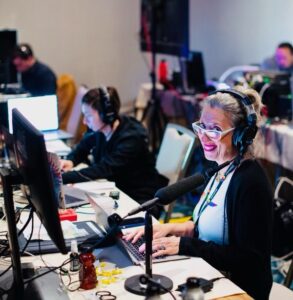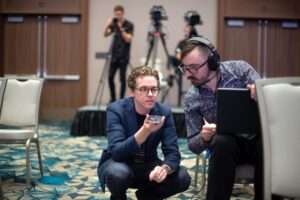Technical Producing and Show Calling for an AI Engineer Tech Conference
When people ask me what my job is, I tell them I make magic for a living. But it’s a little less “Abra Cadabra” and a little more “Wizard of Oz.”
You see, I am the proverbial man behind the curtain.
I’m a Live Event Technical Producer with Talon Audio Visual, specializing in managing Audio Visual technology and teams for corporate events. My job is to transform a conference from the dreaded ‘Death by PowerPoint’ into a magical place where the audience learns, makes connections, and gets inspired.
Making Fire from Sticks: Building AV for a Summit from Scratch

In the live event production industry, we are in the storytelling business. But I don’t consider myself a storyteller. Instead, I’m a placemaker – my colleagues and I build the campfire, put out the s’mores, and literally set the stage for our clients to tell their stories. We stage the show.
It’s hard to explain to an outsider what exactly an event producer does, but broadly, here goes: Most events start with an empty room. Literally. Four walls, a floor, and a ceiling. (Unless we’re outside.) Next time you attend a conference, look around – literally everything from the carpet up (and often the carpet too) has been set up just for you. An event production team brought in the chairs you are sitting in, the stage the speakers are standing on, the set design, the sound system, the video screens, and the lights. It’s all custom-built for your event, from a toolbox of building blocks that we combine and recombine to make each show unique.
From the moment you walk in the door, every experience has been designed and scripted. The positioning of the registration desk, the uniform of the staff who greet you, the music playing as you sit down, and the booming “Voice of God” who welcomes you to the event. More on this later.
Technical Production: Translating Creative Vision to Conference Reality
My job as a Technical Producer is to take my client’s creative vision for your experience and figure out how to translate those ideas into reality using technical know-how and tools from that big chest of Lego pieces. Part of that task is to mediate between the clients’ dreams and the tech team’s constraints by explaining the opportunities and limitations of various technologies, which means compromising to achieve the best show possible.
Using light, sound, motion, and fabric, we carefully craft an environment for each event and set the stage for a magical moment. And yes, drapery is a huge part of the Audio-Visual industry – we are the people behind the curtain, after all.
Just like the Wizard, we use tricks of the trade, sleight of hand, and strings from above to construct the experience for our audience. Every movement, song, and announcement is carefully scripted and rehearsed. But live events are, at the end of the day, live events, and things don’t always go as planned.
That’s when another hat I wear comes into play. I’m often the “Show Caller” (like a stage manager in a theater), following the script for the event, and calling out instructions, or cues, for the technical team. When the show goes off script it’s the Show Caller who steers the ship to get back on course.
A Voice from the Heavens? Or Just from Backstage?

Remember the “Voice of God” announcements (or VOGs as we call them)? They are often pre-recorded, which is great for quality control, but as details change daily, hourly, and sometimes minute by minute, it’s hard to edit a recording made a week ago. And that’s where creative voice actors like Debbie Irwin come in. I had the pleasure of working with Debbie as a live, in-person “Voice of God” at the recent Inaugural AI Engineer Summit in San Francisco, a 500-person conference co-founded by Benjamin Dunphy and Swyx, two cutting-edge thinkers and doers. Argus HD managed the Audio/Visual (A/V) technology and setup. Debbie sat backstage (behind the curtain of course) and encouraged people to take their seats, welcomed our speakers to the stage, and introduced breaks and housekeeping reminders.
So much to do, so little time: Our AI Engineer Summit tech crew might be bigger than you realized
This was a fairly intricate production for the size of the show, and we had a deep bench to keep the show flowing. Twenty-four people in all.
Our crew at Front-of-House (FOH) – the tech table at the back of the audience had 5 people:
- Show Caller
- Audio engineer (A1) who controls the microphones and audio playback
- Lighting Designer who operates the lighting console to light the stage and gives us special lighting effects on cue
- 2 Camera Operators controlling the long-lens cameras for the event
The rest were working Backstage:
- Robotic Camera Operator
- Project Manager (PM)
- Playback Operator controlling video playback and motion graphics
- Graphics Operator controlling the slides
- Broadcast Video Director who directed the live-stream
- Broadcast Assistant
- Streaming Engineer
- 2 LED Wall Techs who set up and maintained the LED screen
- High-Res Switcher Operator controlling the sources going to the LED wall

Benjamin Dunphy and Tim Kerbavaz discuss event strategy. | ©Randall Gee Photography - Deck Manager/Demo Tech, stationed just off the stage, to help presenters get their laptops connected on the stage lecturn and cue all the speakers when to walk out on stage.
- Audio Assistant (A2) who works backstage, monitoring and tracking wireless microphone systems, setting up intercom, and getting talent mic’d up and ready to go on stage.
- Our live VOG
- 6 person setup and teardown crew who were there to help us get all the equipment off the truck and set up in the room and to pack it back up again after the show.
It takes a lot of people and a lot of coordination to hit all of our cues on time. We all wear an intercom headset to whisper in each other’s ears, and for the crew to listen to the Show Caller’s directions. Cues can evolve quickly on a complex show, and this project involved lots of on-the-fly changes to content and speaker timing, so constant communication was essential.
Having our voice talent onsite meant that when there were changes in the schedule, the speakers, the time slots, and the break times our announcements were always correct and timely. Unlike having an actor record the scripts remotely in advance, having

Debbie onsite and on the intercom system with the whole crew meant that as the show progressed she always knew what was next, how much time we had until she spoke, and was ready to adjust the script and timing to make sure our audience always had the correct information.
In event production, our job is to be invisible. We both literally and figuratively amplify the message of the speakers on stage while we make sure you pay no attention to the folks behind the curtain. We wear black to blend into the shadows. But we want to make sure you, our audience, get the right information at the right time. And for that, you might have to say that Heaven is a Voice on Earth.
—-
Tim Kerbavaz is a Technical Producer and live event technical consultant at Talon Audio Visual.